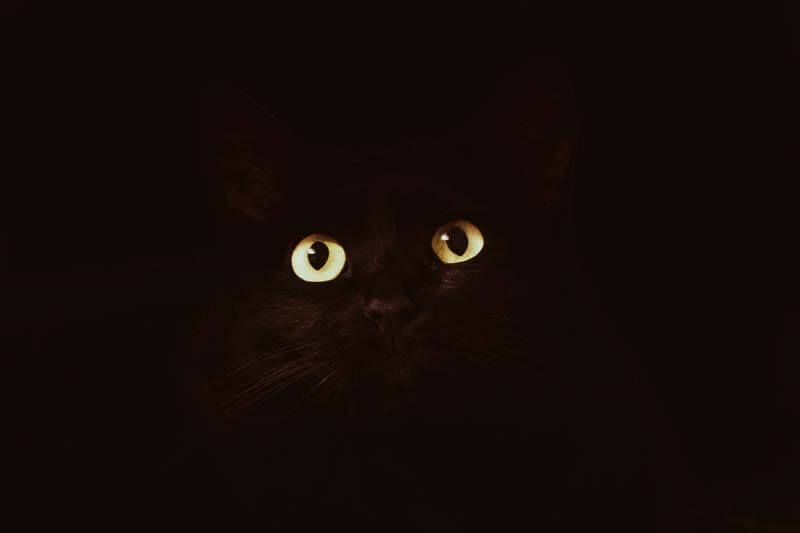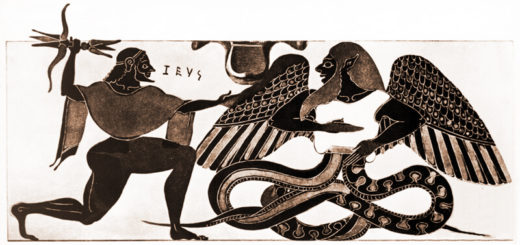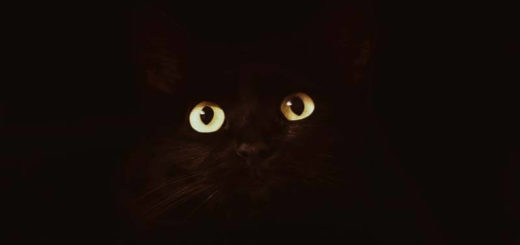Animal ghosts: Cat and Cock Phantoms and Mysteries
Animal ghosts form a special paranormal department. Next to dogs, goats, toads and horses, cats and cocks, especially the black ones are surrounded by superstitions, mysteries, legends and ghost tales. The cat, as appears from many legends, easily holds the place amongst mystic animals that the serpent has among reptiles, partly no doubt because of its close relationship with sorcerers and witches.

adapted for blog from: Human Animals – by Peter Hamel
Among the strange animal-gods and goddesses of Egypt none is more famous than the goddess Sekhet and Bast of Bubastis, who sometimes has the head of a lion, sometimes of a cat. The early inhabitants of the valley of the Nile were better acquainted with the lion than with the cat, which was first introduced from Nubia in the eleventh dynasty. In the time of the old Empire there was no cat-headed deity chiefly because there were no cats. When once introduced, the cat became a sacred animal and Sekhet’s lion-head was superseded by a milder feline form. The Egyptians also believed that Diana, wishing to escape from giants, chose to hide herself in the form of a cat.
Ghostly cats in Japan and France
Cats, like foxes, are credited in Japan with the power of assuming human shape in order to bewitch mankind. The two-tailed vampire cat destroys a beautiful maiden and, taking her form, preys on a handsome prince.
A man who kills a cat is liable to be possessed by a cat, and he prevents this if he eats part of the animal. This homeopathic cure is called cat-punishment. At Aix in Provence, on the day of Corpus Christi, the largest tom-cat is dressed in swaddling clothes and publicly exhibited in a magnificent shrine.
There is a well-known story of a traveller who saw a procession of cats in a ruined abbey lowering a small coffin with a crown on it into a grave. Filled with fear, he rushed from the spot and later told his vision to a friend. The friend’s cat lay curled up quietly before the fire, but, hearing the story, it sprang up and crying out, “Now I am king of the cats!” disappeared in a flash up the chimney.
An inhabitant of Toulon told Bérenger-Feraud, in 1875, that one of his friends had a wizard cat. Every evening the cat used to listen to their conversation, and if the subject interested him, he expressed his own opinion, usually saying the last word on the topic. If his mistress had any plans on hand, she consulted the cat, giving her reasons for taking one course or another. After having weighed the pros and cons carefully, the cat used to advise her by saying “yes” or “no” as to whether her plans could be carried out or not.
The cat used to speak whenever he wanted food, asking either for fish or meat to be purchased, and he talked very indignantly if the required dainty was not forthcoming.
From time to time this uncanny animal disappeared for many days at a stretch; and the members of the household were convinced that he had taken human form in his absence. He always used to speak before leaving and after returning.
When he lay on the point of death he prayed that his body might be decently buried, and his mistress gave him a solemn promise to this effect and laid the corpse in a box which she interred behind the cemetery wall. She dare not bury it in the grave prepared for human beings, but the coffin was laid alongside a Christian tomb, and at the funeral the cat’s soul was recommended to the care of his Creator.
Revengeful cats
Wizard cats have been known to do serious harm to those against whom they have a grudge, and it is well to be sure, if you value your life, whether you are dealing with a real animal or a “familiar” when you feel angry.
A young man in Radnorshire had the reputation of being very cruel to cats. On the day he was to be married he saw a cat cross his path, and he threw a stone at it. From that moment he weakened in health and had to go away frequently to recuperate. The neighbours said that during these absences he was changed into a cat and ran wild in the woods and, after his death, tradition declared that he wandered through the district at night in the shape of a cat and struck terror in the hearts of naughty children.
Soul enters cat after death
General Sir Thomas Edward Gordon tells the following story of a modern instance in which a man was said to be transformed into a cat after death.
“For twenty-five years an oral addition to the written standing orders of the native guard at Government House near Poona had been communicated regularly from one guard to another on relief, to the effect that any cat passing out of the front door after dark was to be regarded as His Excellency the Governor, and to be saluted accordingly. The meaning of this was that Sir Robert Grant, Governor of Bombay, had died there in 1838, and on the evening of the day of his death a cat was seen to leave the house by the front door and walk up and down a particular path, as had been the Governor’s habit to do after sunset. A Hindu sentry had observed this, and he mentioned it to the others of his faith, who made it a subject of superstitious conjecture, the result being that one of the priestly class explained the mystery of the dogma of the transmigration of the soul from one body to another, and interpreted the circumstance to mean that the spirit of the deceased Governor had entered into one of the house pets.
“It was difficult to fix on a particular one, and it was therefore decided that every cat passing out of the main entrance after dark was to be regarded as the tabernacle of Governor Grant’s soul, and to be treated with due respect and the proper honours. This decision was accepted without question by all the native attendants and others belonging to Government House. The whole guard, from sepoy to sibadar, fully acquiesced in it, and an oral addition was made to the standing orders that the sentry at the front door would ‘present arms’ to any cat passing out there after dark.”
A strange cat-story
A strange cat-story is told in “Notes and Queries,” by a writer who knew the lady who had seen the ghost.
The lady was living with her father about 1840 in an ancient country-house which he had rented from an elderly heiress. The inmates soon discovered that the house was haunted. Strange noises were heard from time to time in the dining-room at night: a mysterious black cat used to appear in the entrance hall in the evening and scamper straight up the main staircase—not ascending it in the manner of mortal cats, but by winding itself in and out of the balustrade in a decidedly uncanny and preternatural way; and, worst of all, an old gentleman, in a black skull cap, yellow dressing-gown and red slippers, would come at midnight out of a certain door, cross the hall, go upstairs (in a dignified manner and not as the cat did) and vanish into an empty bedroom on the first floor.
All the members of the household used to hear the noises and see the old gentleman whenever they were awake and downstairs at midnight. As to the “tortuous cat,” it was vouched for by the servants and duly recorded by the lady who told the story. At length the inmates, finding the situation unpleasant, courageously determined to beard the ghost and give the old gentleman a practical and straightforward remonstrance about his conduct. On a certain night four men-servants were accordingly posted on the staircase, at the head of the first flight of stairs, it having been arranged that they should stop the intruder if they could, while their master, with a loaded pistol, should follow him and cut off his retreat.
At midnight the venerable gentleman emerged from his accustomed door. “Here he is!” cried the master of the house, and the servants on the staircase held their ground whilst the old gentleman approached silently, apparently unconscious of their presence. He came close up to the dauntless four, and then, to their amazement, he passed straight through them and reappeared on the other side. Turning round, they saw him calmly gliding up the second flight of stairs, above that on which they were posted. The master of the house, calling on them to follow, gave chase and fired his revolver. The old gentleman took no notice of the shot and entered the empty bedroom as usual, through its closed door. His pursuers opened the door only to find the room empty. A thorough search was made, the wainscoting sounded, the chimney explored, the cupboards turned out, and so forth, but nothing was found but a box containing deeds and some money in a forgotten closet.
The next morning the occupier wrote to the owner of the house to tell her of the discovery of the deed-box, and at the end of his letter, he inquired casually whether any of her relatives had been noted for a peculiarity of dress.
She replied that her grandfather always used to wear, when he was at home and in his study, a black skull cap, a yellow dressing-gown and red slippers.
After the finding of the deed-box the ghost failed to reappear and the companion phantom cat no longer did gymnastic exercises on the balustrade.
Witch-cats or were-cats
A different cause no doubt lies at the root of the appearance of a phantom cat and of a witch-cat, but it is not always easy to distinguish between the varieties of apparitions. The animals in the following stories bear resemblance to witches’ familiars.
A woodman whose dinner was stolen from him daily by a cat made many attempts to waylay the creature. At last he succeeded in catching it in the act of larceny and he chopped off one of its paws, only to find on his return home that his wife had lost a hand.
A Frenchwoman at Billancourt was cooking an omelette when a black cat strayed into the cottage and sat down near the hearth to watch the operation. At the critical moment the cat cried out, “The omelette is done on that side. Turn it.” The old woman was indignant at this aspersion on her culinary knowledge and she flung the half-cooked omelette at the cat, striking the animal’s face. The next morning she had the satisfaction of seeing a deep red burn on the cheek of an evil-minded neighbour.
A woman whose children were always ailing, lived in the village of Ceyreste near to Ciotat. As soon as one child recovered another fell ill, and their mother was in despair, because she could not account for their ailments.
One day, one of her neighbours said, “Do you know, I feel sure your mother-in-law is injuring the health of your little ones. She may be a witch.”
The woman spoke to her husband about the matter, and they decided to watch over their children carefully to see whether their illness was due to evil influence.
One night they were watching without appearing to do so, when suddenly a black cat approached the cradle of one of the children, moving with stealth and quite silently. The husband raised a stick he had picked up for the purpose and struck the animal violently, intending to kill it. But the blow was not carefully aimed and he only succeeded in crushing one of the evil animal’s paws. With a bound it escaped him.
For a day or two afterwards nothing was seen of the children’s grandmother, who usually came on a visit every day to inquire after the health of her grandchildren.
Then the neighbour said, “She is hiding something from you. Go and see why she does not come.”
The husband followed her advice and went to see his mother, whom he found with her hand bound up, and in an extremely bad temper. He pretended not to see that she had been hurt, and he asked her in the most natural tone he could summon, why she had not been to visit them as usual.
“Whatever should I come to your house for?” she asked angrily. “Look at the state of my fingers. If I had been struck by a hatchet instead of a stick, my fingers would have been cut off and I should have nothing left but a stump.”
Algernon Blackwood used this idea of the astral body assuming cat-shape
Mr. Algernon Blackwood has cleverly used this idea of the astral body assuming cat-shape, and a wound inflicted on the animal reproducing itself on the physical counterpart, by means of the so-called phenomenon of repercussion.
In “The Empty Sleeve,” (1911) the violinist Hyman “believed that there was some fluid portion of a man’s personality which could be projected to a distance, and even semimaterialised there. The ‘astral body,’ he called it, or some such foolishness, claiming that it could appear in various forms, according to the character of its owner’s desire, even in animal forms.”
Billy Gilmer described to his brother what he saw when the violinist was playing. “The music seemed to issue from himself rather than from the shining bit of wood under his chin, when—I noticed something coming over me that was”—he hesitated, searching for words—”that wasn’t all due to the music.”…
“You mean Hyman looked queer?”
Billy nodded his head without turning.
“Changed there before my very eyes”—he whispered it—”turned animal——”
“Animal!” John felt his hair rising.
“That’s the only way I can put it. His face and hands and body turned otherwise than usual. I lost the sound of his feet. When the bow-hand or the fingers on the strings passed into the light, they were”—he uttered a soft, shuddering little laugh—”furry, oddly divided, the fingers massed together. And he paced stealthily. I thought every instant the fiddle would drop with a crash and he would spring at me across the room.”
Some weeks later John Gilmer is awakened by a noise in the flat, and seizing a Turkish sword from the wall where it hung he entered the sitting-room where he saw a moving figure.
“Clutching his Turkish sword tightly he drew back with the utmost caution against the wall and watched, for the singular impression came to him that the movement was not that of a human being crouching, but rather of something that pertained to the animal world. He remembered, flash-like, the movements of reptiles, the stealth of the larger felines, the undulating glide of great snakes. For the moment, however, it did not move, and they faced one another.
“The other side of the room was but dimly lighted, and the noise he made clicking up another electric lamp brought the thing flying forwards again—towards himself. At such a moment it seemed absurd to think of so small a detail, but he remembered his bare feet, and, genuinely frightened, he leaped upon a chair and swished with his sword through the air about him. From this better point of view, with the increased light to aid him, he then saw two things—first, that the glass case usually covering the Guarnerius violin had been shifted: and, secondly, that the moving object was slowly elongating itself into an upright position. Semi-erect and yet most oddly, too, like a creature on its hind legs, it was coming swiftly towards him. It was making for the door—and escape.”
Confused, he struck out wildly, lost his balance and fell forward from the chair.
“Then came the most curious thing of all, for as he dropped, the figure also dropped, stooped low down, crouched, dwindled amazingly in size, and rushed past him close to the ground like an animal on all fours. John Gilmer screamed, for he could no longer contain himself. Stumbling over the chair as he turned to follow, cutting and slashing wildly with his sword, he saw half-way down the darkened corridor beyond, the large, scuttling outline of—a cat!
“The door into the outer landing was somehow ajar, and the next second the beast was out, but not before the steel had fallen with a dreadful crashing blow upon the front disappearing leg, almost severing it from the body.”
Months afterwards the Gilmers met Hyman wearing spectacles and a beard. William pointed out to his brother another difference.
“But didn’t you also notice——”
“What?”
“He had an empty sleeve.”
“An empty sleeve?”
“Yes,” said William. “He’s lost an arm!”
Mysterious cat-story of French origin
A daring cat-story is of French origin and bears distinctive national characteristics on the face of it. On the 26th of March, 1782, a gentleman of wealth who was jealous of his wife’s honour, decided he would consult Count Cagliostro, in order to find out whether his wife, who was young and beautiful, had always been faithful to him. He told the Count the reason of his visit and begged him to assist him in discovering the truth. Cagliostro said that this was quite an easy matter, and that he would give him a small phial containing a certain liquid which he was to drink when he reached home and just before he went to bed. “If your wife has been unfaithful to you,” said Cagliostro, “you will be transformed into a cat.”
The husband went home and told his wife how clever the Count was. She asked him the reason of his journey. At first he refused to tell her, but when she insisted he told her the exact means by which he was going to test her fidelity. She laughed at his credulity, but he swallowed the draught and they went to bed. The wife rose early to attend to her household duties, leaving her husband asleep. At ten o’clock, as he did not appear, she went up to wake him, and to her intense astonishment, she found a huge black cat in the bed in place of her husband. She screamed, called her dear husband’s name, and bent over the cat to kiss it, but without avail. Her husband had vanished! Then, in her despair, she knelt beside the bed and prayed for pardon, saying that she had committed a sin and that a handsome young soldier had cajoled her, by means of vows, of tears, and stories of heroic battles, to forget her marriage vows.
Black cocks and hens
Black cocks and hens—like the cat—appear to have affinity with ghosts and sorcery. Among the fauna of La Franche Comté black hens are found, gifted with supernatural powers, which are so much like the ordinary ones that it is difficult to tell them apart. Yet they are magicians well versed in sorcery. In the courtyard they are served before their companions, and when they become broody and sit on the nest, a piece of money is slipped beneath them. If they are pleased, other coins are added, but it is very difficult to please them. At Mouthe in the Jura mountains, there are said to be witch-hens that frighten eagles. Cocks are also thought to have power over lions. Proches gives an example of a spirit which was wont to appear in the form of a lion, but by setting of a cock before it, it was made to disappear, because there is a contrariety between a cock and a lion.
If an unexpected fortune is left to a poor peasant the French say that “he has a black hen,” and the black hen which brings treasure is given by the devil to those who have sold their soul to him. A black cock is regarded as lucky, and use is made of it in ceremonial magic.
Oromasis, father of Zoroaster, possessed a gold-finding hen which was hatched in the following manner. “Take aromatic woods, such as aloes, cedar, orange, citron laurel, iris-root, with rose leaves dried in the sun. Place them in a golden chafing-dish, pour balsamic oil over them: add the finest incense and clear gum. Next say: Athas, Solinain, Erminatos, Pasaim: set a glass over the chafing dish: direct the rays of the sun thereon, and the wood will kindle, the glass will melt, a sweet odour will fill the place, and the compost will burn speedily to ashes. Place these ashes in a golden egg while still red-hot: lay the egg upon a black cushion; cover it with a bell-glass of faceted rock-crystal; then lift up your eyes and stretch your arms towards heaven and cry: O Sanataper, Ismaï, Nontapilus, Ertivaler, Canopistus. Expose the glass to the most fierce rays of the sun till it seems enveloped in flame, the egg ceases to be visible and a slight vapour rises. Presently you will discern a black pullet just beginning to move, when, if you say: Binusas, Testipas, it will take wing and nestle in your bosom.”
An alternative method provided by the Grimoire is to take an unspotted egg, and expose it to the meridian rays of the sun. Then select the blackest hen you can get, and shut it in a box lined with black. Place the box in a darkened room and let the hen sit till it hatches the chicken, which should be as black as the hen’s outlook. The black pullet should have gold-finding proclivities. Another method altogether is to secure a virgin black hen, which must be seized without causing it to cackle. Repair to the highroad, walk till you come to a cross-way, and there, on the stroke of midnight, describe a circle with a cypress rod, place yourself in the middle, tear the bird in twain, and pronounce thrice the words Eloïm, Essaim, frugativi et appellavi. Next turn to the east, kneel down, recite a prayer, and conclude it with the Grand Appellation, when the Unclean Spirit will appear to you in a scarlet surcoat, a yellow vest, and breeches of pale green. His head will resemble that of a dog, but his ears will be those of an ass, with two horns above them; he will have the legs and hoofs of a calf. He will ask for your orders, which you will give as you please, and as he cannot do otherwise than obey you, you may become rich on the spot, and thus the happiest of men. Such at least is the judgment of the Grimoire.
Samuel Bernard, the Jewish banker who died in 1789, left an enormous fortune. It was said that he possessed a favourite black cock as a mascot, which was thought by many to have supernatural powers and to be connected in the diabolical manner indicated with the amassing of his wealth. The bird died a day or two before his master.
A cock was tried for having laid an egg
At Basle, in 1474, a cock was tried for having laid an egg. After a long examination the cock was condemned to death, not as a cock but as a sorcerer or devil in the form of a cock. The bird was burned with its egg at the stake! In former times all animals were regarded as amenable to the laws of the country and the whole proceedings of the trial, sentence, and execution were conducted with the strictest formalities of justice. Ninety-two processes against animals were tried in the French courts between 1120 and 1740, when the last trial and execution of a cow took place.
At Lavegny, in 1457, a sow and her six young ones were tried for having murdered and partly eaten a child. The sow was found guilty and executed, but the pigs were acquitted on account of their youth and the bad example of their mother.
Such instances might be multiplied in number, but they have no real place here, as the victims of justice were not regarded in the light of human animals, but as animals which had broken the standard of conduct laid down for the so-called superior race.
Chanticleer is the name of the cock in the great beast epic of the Middle Ages, Reynard the Fox, and Chanticleer, as everyone knows, has been humanised and immortalised in recent years by the famous French dramatist, Rostand. The cock, the hawk, and the eagle, among birds, appear to attract wizards or male sorcerers for transformation purposes, while the more graceful and docile feathered beings, such as the nightingale, the wren, and above all the swan, appeal more frequently to the witch or maiden as a suitable form in which to appear.
Admirers of William Blake’s work will remember the curious conception of a woman with a swan’s head depicted in his “Jerusalem.”
After the classic swan-maidens and Valkyries, perhaps the owl-woman comes next in popularity, made famous no doubt by the transformation of Pamphile in “The Metamorphosis, or Golden Ass of Apuleius.”






